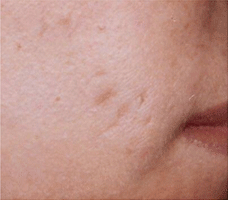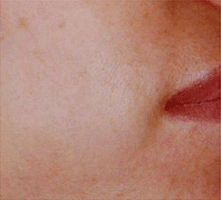Acne Therapy in San Diego
Acne vulgaris
Acne is an inflammatory disease of the skin, caused by changes in the pilosebaceous units (skin the hair follicle and sebaceous gland).
- The typical acne lesions are: comedones, papules, pustules, nodules and inflammatory cysts.
- After resolution of acne lesions, prominent (but temporary) hyperpigmentation is common and permanent scarring may also occur.
- Several factors occur in combination to cause acne, including hormonal changes, plugged pores and secondary bacterial overgrowth in the hair follicle and sebaceous gland units.
- Further research is necessary to establish whether reducing the consumption of high-glycemic foods (such as soft drinks, sweets, white bread) can significantly alleviate acne.
- There is no way to predict how long it will take for acne to disappear entirely.
- Current treatments for acne (these are often used in combination for best results):
- Exfoliation therpies (creams, toners, masks)
- Topical antibacterial medications
- Oral antibiotics
- Hormonal therapies (oral contraceptive pills, spironolactone, cyproterone acetate)
- Topical retinoids (tretinoin, adapalene, tazarotene)
- Isotretinoin (an oral retinoid medication)
- Blue light phototherapy (Levulan-Blu-U (Photodynamic Therapy)) with or without aminolevulinic acid (Levulan)
- Laser therapy
Types of Acne Scars
- Hypertrophic scars: raised, firm thickenings of skin, sometimes red, most commonly occur on back and shoulders.
- Atrophic scars: depressed skin (lower than surrounding skin).
- Pitted scars: deep, narrow scars that are nicknamed “ice pick scars” due to their appearance.
- Acne scars are not the purple, brown or red discolorations that are noticed on the skin immediately after a pimple heals. These marks are called post-inflammatory hyperpigmentation (PIH). PIH resolves gradually over months, and it does not leave scars in most cases.
 Before Treatment
Before Treatment After Treatment
After Treatment
Tools Used to Improve or Clear Acne Scars
- Subscission - a needle is used to break underlying scar adhesions.
- Chemical peels can smooth textural abnormalities if they are mild.
- CROSS technique (Chemical Reconstruction Of Skin Scars) with tricarboxylic acid (TCA) is a local (applied only to the scar) treatment that is useful for pitted scars.
- ThermaScan laser (1319nm) helps to reorganize and regenerate collagen and other connective tissue in the dermis in a nonablative (no wound) fashion.
- Resurfacing lasers (Erbium, CO2, Fraxel) also smooth the skin surface. They are ablative and semi-ablative lasers that do create a skin wound. The depth of wound and healing time depend on the device that is used.

